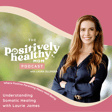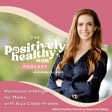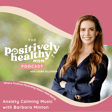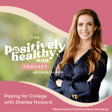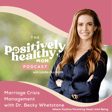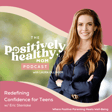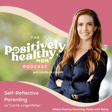Become a Creator today!Start creating today - Share your story with the world!
Start for free
00:00:00
00:00:01

The Ten Minute Tidy and Other Tips to Keep Your Home Organized
In our thirty-fourth episode, titled "The Ten Minute Tidy and Other Tips to Keep Your Home Organized," we're delighted to welcome back Sara Fritsch, an expert organizer from the hills of Austin.
Sara's passion for creating inspiring living spaces shines through as she shares practical strategies for maintaining a clutter-free home environment. From the ten-minute tidy to other ingenious techniques, Sara's insights offer valuable tools to help busy moms stay organized and promote a sense of calm and well-being in their homes.
Tune in to discover how implementing Sara's tips can bring positive transformations to your life and family. 🌟🏠
Positively Healthy Coaching
The Positively Healthy Mom FB Group
Transcript
Introduction to Positively Healthy Mom and Guest
00:00:00
Speaker
Hey moms, it's Laura Olinger.
00:00:02
Speaker
Welcome to the Positively Healthy Mom podcast.
00:00:05
Speaker
Because there's no manual for the hardest job in the world.
00:00:09
Speaker
Welcome to part two of my conversation with Sarah Fritsch, founder of Moxie Space Professional Organizing.
Organizing Strategies for Busy Parents
00:00:16
Speaker
So I would love to transition a little bit more into like practical tips and tools.
00:00:23
Speaker
So imagine that you have, you know, a client who, you know, has got lots of kids and they've got a very busy life and they are just always on the go.
00:00:34
Speaker
And the problem is they imagine if they would hire an organizer that the house would then be messy again in a week.
00:00:41
Speaker
Right.
00:00:42
Speaker
Like what I'm wanting to like share with the audience is, you know, how do you come into a home, you know, get it all clean and organized, but then help the client learn how to maintain it and the client as the parent, but help the parent then teach the kids.
00:00:58
Speaker
These are the new systems.
00:00:59
Speaker
This is how we want to do it.
00:01:00
Speaker
So, so what do you offer when situation?
00:01:04
Speaker
Yeah.
00:01:05
Speaker
Well, so first and foremost, if our goal is that we are setting up extremely simple systems and I use the word system, but that is, that just means like, where does the mail go when it comes to the front door?
00:01:21
Speaker
You know, the, the incoming mail, what's the system for that?
00:01:24
Speaker
Does it get tossed onto the kitchen Island?
00:01:27
Speaker
Yeah.
00:01:28
Speaker
for the for a week you know and then maybe it gets dealt with maybe it never does and maybe it gets lost or whatever like that's that's a system i mean it's not functioning but so a system just means like what's the process you know and so our goal is always always to set up the most simple system possible and in fact um we really feel like if you have to go through more than like two steps to access something in your home
00:01:52
Speaker
it's that's too many steps.
00:01:54
Speaker
So you can think of like, put, let's, let's start with toys.
00:01:59
Speaker
You know, putting toys away.
00:02:00
Speaker
If you set up a system and especially for younger children, right, it's going to be even more, maybe more challenging is say that, you know, their toys are put away.
00:02:10
Speaker
inside a bin that has a lid on it.
00:02:12
Speaker
And that bin goes inside a cabinet and that cabinet has a door on the front of it, right?
00:02:16
Speaker
So you've got to open the door and then pull out the bin and then take off the lid.
00:02:22
Speaker
It's like that's three steps, right?
00:02:24
Speaker
That's a lot to put away toys.
00:02:26
Speaker
That's not a system that is likely going to stay or that anybody's going to use.
00:02:31
Speaker
What's
Balancing Functionality and Aesthetics
00:02:32
Speaker
going to start happening is they're going to open the cabinet door, maybe hopefully, and maybe just shove it, maybe just throw it in the thing.
00:02:39
Speaker
So the best, you know, if you had to keep the cabinet door, then the best thing would be to have a bin with no lid.
00:02:44
Speaker
Right.
00:02:44
Speaker
So they can just, but they still have to open the door, pull the lid out, you know, maybe best thing is to lose the cabinet door altogether.
00:02:51
Speaker
Maybe.
00:02:51
Speaker
Right.
00:02:52
Speaker
But sometimes you got, you want stuff to be put away.
00:02:54
Speaker
So there's a balance, right?
00:02:56
Speaker
There, there certainly is a balance with organizing of like finding something that is functional and works, but also looks nice.
00:03:04
Speaker
And I don't think that we should,
00:03:07
Speaker
throw out one thing.
00:03:08
Speaker
I think aesthetics matter.
00:03:10
Speaker
I think beauty matters.
00:03:12
Speaker
And if the idea of being organized is to
00:03:16
Speaker
help us have a home that helps us relax, I would love for beauty to be a part of that, you know, because I don't know, I think beauty is relaxing, I guess, you know, it's like, why not, right?
00:03:28
Speaker
We don't have to, and I think, you know, sometimes we can over-organize stuff, right?
00:03:32
Speaker
And have, you know, dozens and dozens of bins, and then it's kind of like, whoa, like there's so much in here.
00:03:41
Speaker
So there is like an aesthetic balance, I think, that ideally goes with organizing.
00:03:46
Speaker
But talking about like simple, simple systems are going to be the easiest to maintain.
00:03:52
Speaker
So when we're going in, we're organizing a whole house and I get that all the time.
00:03:55
Speaker
You know, I don't know if I want to spend this money on, on, on your service because I think it's just going to go back that way in a week or two.
00:04:01
Speaker
Right.
00:04:02
Speaker
And now of course, part of staying organized does require a shift in habits.
00:04:08
Speaker
No question.
00:04:09
Speaker
Right.
00:04:10
Speaker
If we're going to set up a system that involves everybody taking their shoes off at the door,
00:04:16
Speaker
And no one has ever taken their shoes off at the door.
00:04:18
Speaker
But now we have a nice bench, a shoe bench.
00:04:22
Speaker
Maybe everybody in the family has their own cubby for their shoes and their name is on it.
00:04:25
Speaker
That's wonderful.
00:04:26
Speaker
And it's a simple system.
00:04:27
Speaker
Let's say it's very simple.
00:04:29
Speaker
But the fact is, is nobody's ever taken off their shoes at the door ever before.
00:04:32
Speaker
So how do we get that to happen?
00:04:34
Speaker
Right.
00:04:35
Speaker
So it's like one of two things is going to happen.
00:04:37
Speaker
Either one, we're going to start using some sort of a trigger mechanism or, you know, something where we, you know, we stack these habits and,
00:04:47
Speaker
I can't even really come up with an example, but where we're trying to get, we're trying to change our habits so that when we walk in, we take our shoes off.
00:04:55
Speaker
You know, maybe we put a new rug that says, take your shoes off.
00:04:58
Speaker
Maybe there's a sign that says, take your shoes off.
00:05:00
Speaker
And it's there for three weeks until everybody learns to take their shoes off.
00:05:03
Speaker
Right.
00:05:04
Speaker
Or maybe what happens is no one is ever going to take their shoes off at the door.
00:05:08
Speaker
It's never going to happen.
00:05:10
Speaker
The shoes get taken off.
00:05:13
Speaker
somewhere else in the house, right?
00:05:15
Speaker
So maybe the system actually needs to be set up over here where the shoes get taken off naturally.
00:05:20
Speaker
There really is like, there's some choices.
00:05:23
Speaker
It's like, do you develop the system where it's already happening or do you try to come up with this brand new system?
00:05:30
Speaker
and then get everybody to follow this new system.
00:05:32
Speaker
It's possible, it's possible, but sometimes you have to ask yourself, like, am I just trying to create something that's not gonna exist?
00:05:40
Speaker
Okay, and then of course it comes down to like, well, how do you get your kids on board?
00:05:43
Speaker
How do you, A, I'm learning a new system.
00:05:46
Speaker
Hopefully it's very, very easy.
00:05:48
Speaker
And if it's not easy and simple, it's gonna fall apart like 99% of the time.
00:05:54
Speaker
So you have to ask yourself that too.
00:05:55
Speaker
Like, if it's just too complicated, then it's probably not gonna last.
Family Involvement in Organization
00:05:59
Speaker
Um, but I, I don't know.
00:06:01
Speaker
I, I think that we learn by watching and we learn by example.
00:06:05
Speaker
And of course I think parents are always told lead by example.
00:06:08
Speaker
And I think that it really is helpful to think of that when it comes to teaching your kids how to organize.
00:06:14
Speaker
Like if you were, you know, you're getting onto them about not putting their things away, but your things aren't put away either.
00:06:21
Speaker
That's hard, right?
00:06:22
Speaker
That's hard to, um, emphasize and, um,
00:06:26
Speaker
So I, you know, I, when I talk to parents and they're trying to figure out how to get their kids on board, I just say, okay, first you get your systems in order.
00:06:34
Speaker
You focus on your own place.
00:06:36
Speaker
You put the mail away when you come in, you know, you hang your coat up and maybe, so maybe you're fine.
00:06:40
Speaker
You're doing all these things or once you're doing all these things, then I think, you know, asking them to, to, um,
00:06:48
Speaker
I'll just keep going with the shoes.
00:06:49
Speaker
Right.
00:06:50
Speaker
It's like you're, you're going to have to remind them to take their shoes off at the door for a while until it becomes a habit.
00:06:57
Speaker
Something that we talk about a lot, just we, as in Moxie spaces, we like to call it the 10 minute tidy, the 10 minute tidy.
00:07:06
Speaker
It's 10 minutes a day.
00:07:09
Speaker
Ideally it's the same time every single day.
00:07:11
Speaker
So maybe it's in the evening, maybe it's right after dinner, maybe it's right before dinner.
00:07:16
Speaker
depending on how your day flows and your family's day flows.
00:07:19
Speaker
But ideally it's kind of around the same time every day.
00:07:21
Speaker
And eventually, ideally the whole family gets involved.
00:07:25
Speaker
And I think that that could be maybe the best way to set the example, but also have time to teach and time to do it as a family.
00:07:33
Speaker
And the biggest thing is that you're only doing it for 10 minutes.
00:07:37
Speaker
So you're not trying to do 20 minutes today because you skipped yesterday and tomorrow it's only five and
00:07:43
Speaker
It's like, no, you're trying to set a habit.
00:07:46
Speaker
It's 10 minutes.
00:07:46
Speaker
You'd be amazed.
00:07:47
Speaker
I'm sure all the mothers out there know how much you can get done in 10 minutes, right?
00:07:52
Speaker
You can get a lot done in 10 minutes, especially when you have a timer.
00:07:55
Speaker
And that's the other piece of it all is set a timer for 10 minutes.
00:07:58
Speaker
Maybe it's a 10 minute song in the house or whatever it is.
00:08:01
Speaker
Maybe it's a loud timer.
00:08:02
Speaker
So everybody is hearing it.
00:08:05
Speaker
And, and you just focus on maybe just one area, you know, maybe, and then maybe your kid who, you
00:08:10
Speaker
We'll never take their shoes off at the door there.
00:08:12
Speaker
They're tidying task every evening or whatever it is, is shoes, right?
00:08:16
Speaker
Tidying the shoes by the front door, taking all the excess shoes that, you know, the rain boots that we're not going to need again for three months and putting them in the closet.
00:08:24
Speaker
You know, that's part of the maintenance piece of it all.
00:08:29
Speaker
But I think that the thing about getting organized is one thing.
00:08:35
Speaker
Maintaining it is important.
00:08:38
Speaker
a very important piece.
00:08:39
Speaker
And I think that we miss that a lot.
00:08:41
Speaker
We miss the maintenance and we get frustrated that things don't stay organized, but nothing will stay the way that it was.
00:08:48
Speaker
If you don't maintain it, it's just like working out, right?
00:08:51
Speaker
It's like I worked out seven days of sleep.
00:08:53
Speaker
That's amazing.
00:08:54
Speaker
I don't have to work out again for six months.
00:08:55
Speaker
And it's like, that's not how that works.
00:08:57
Speaker
Unfortunately.
00:08:58
Speaker
Yeah.
00:08:59
Speaker
Yeah.
00:08:59
Speaker
That's the, that's the perfect analogy.
00:09:01
Speaker
And I thought of some fun ideas as you were describing the 10 minute tidy, that's such an ingenious idea.
00:09:07
Speaker
And I thought, what if you had a playlist where it's the same three songs?
00:09:10
Speaker
Cause I don't know, songs are about three minutes.
00:09:12
Speaker
So if you had about three of them, the same three songs every day, and it's like real hype music, like my son who's 14 cleaned up his room on his own without me asking the other a few days ago.
00:09:23
Speaker
And he was blasting his music so loud.
00:09:28
Speaker
I didn't know what was happening in there.
00:09:29
Speaker
And I finally peeked in and he's like folding something.
00:09:32
Speaker
I'm like, Oh, you're cleaning up.
Different Organizing Styles and Partner Cooperation
00:09:37
Speaker
But I think like music, like the part of the cleaning part or organizing part or maintaining it is,
00:09:41
Speaker
is getting the energy, right?
00:09:43
Speaker
Getting yourself in the mood because we're all kind of feeling depleted if it's that middle, end of the day, and to kind of bring the energy back up in the house.
00:09:52
Speaker
And the other thing I thought of as you were saying that is how we brand it.
00:09:55
Speaker
So I just had a post on my mom's group the other day about how a lot of moms get resistance from kids when we call them chores.
00:10:03
Speaker
Because who wants to do a chore?
00:10:05
Speaker
Like, it doesn't sound fun.
00:10:06
Speaker
That sounds kind of like torture.
00:10:08
Speaker
And so it's like, all we have to do is call it something else.
00:10:11
Speaker
And so my advice was to call it a family contribution.
00:10:15
Speaker
And, you know, we all contribute to living in the household.
00:10:17
Speaker
So this is, we all are part of this, this family system.
00:10:21
Speaker
And then I had someone make a comment and she called it something else, our family responsibilities or something like that.
00:10:26
Speaker
And that even worked.
00:10:28
Speaker
And so even if you, you know, I love the 10 minute tidy, like that kind of sounds fun.
00:10:32
Speaker
It sounds catchy, you know?
00:10:33
Speaker
And so it's like, I loved your idea of everybody takes a space or maybe they take space that they're responsible for.
00:10:40
Speaker
Like there's so many ways you could do it, but that would be one way where you're kind of like getting the whole family on board.
00:10:48
Speaker
And so also as we were talking, the next thing I thought of is,
00:10:52
Speaker
You know how they say opposites attract?
00:10:54
Speaker
Well, I'm sure you do this, but inevitably they're in a married couple or a cohabitating couple.
00:11:00
Speaker
There's always a messy person and there's always a clean person.
00:11:02
Speaker
Maybe not always, but probably a lot.
00:11:04
Speaker
So what is your feedback about that?
00:11:08
Speaker
Yeah, that's a great question.
00:11:09
Speaker
It's kind of a similar thing in, well, we get that all the time.
00:11:14
Speaker
We have someone who calls and they say, well, I really want this, but my partner doesn't.
00:11:18
Speaker
Or they say, you know, my partner really needs to get organized.
00:11:23
Speaker
I'm really organized.
00:11:23
Speaker
Like, what should I do?
00:11:24
Speaker
How do I get them organized?
00:11:27
Speaker
I think first and foremost, you can only focus on your own stuff first.
00:11:31
Speaker
So if you're, if you put in the effort and the work to organize your own space, then you have maybe some, a leg to stand on to talk about somebody else's organization.
00:11:45
Speaker
Something interesting though to note is that there are different styles of organizing and they reflect,
00:11:55
Speaker
who we are and the way our own brain works.
00:11:57
Speaker
Right.
00:11:58
Speaker
So some, for instance, like some people feel that they need to see all of their stuff or they'll forget they have it.
00:12:05
Speaker
And then other people feel the exact opposite.
00:12:06
Speaker
Like I know I need to see nothing because I don't want to see it because it makes my brain feel overwhelmed if I can see all my stuff.
00:12:15
Speaker
And so sometimes that means while using clear containers versus opaque, you know, containers you can't see through with labels on the outside.
00:12:23
Speaker
for clear containers with labels, but you can see through the container.
00:12:30
Speaker
And what I'll say is, well, there is an, there's actually, there's an interesting book out there called the clutter connection.
00:12:37
Speaker
And this organizer has broken up four different styles of organizing.
00:12:41
Speaker
And basically everybody falls into one quadrant or actually, actually you lay over two different quadrants.
00:12:47
Speaker
And so that could be helpful.
00:12:49
Speaker
It could be helpful if you are, or if you're with a partner who seems the opposite of you and maybe, um,
00:12:54
Speaker
doing a little bit of research and just digging around to find out maybe they have a different style.
00:13:00
Speaker
And so my style is not going to work for them, but what is their style so that we can find a system that works for them?
00:13:07
Speaker
You know, and I think as with any relationship, there are compromises and there are things that you have to agree to and you stick to it, you know, and you've got to pick your battles and decide what really matters the most.
Maximizing Space with Aesthetic Organizing
00:13:19
Speaker
Sometimes bringing in outside help, like an organizer can be a really great solution.
00:13:24
Speaker
I will say that we have heard so many times, um,
00:13:29
Speaker
And it doesn't always land like this.
00:13:32
Speaker
I will say this.
00:13:33
Speaker
But more often than not, it's usually the wife hires us and the husband was not.
00:13:38
Speaker
He was not sold on the whole thing.
00:13:40
Speaker
Maybe he finally agreed to allowing it to happen.
00:13:43
Speaker
But it's after we do our work that the husband is amazed and blown away and they're ready to have us back.
00:13:50
Speaker
And so sometimes it's just they need to see it to believe in it.
00:13:55
Speaker
You know what I mean?
00:13:57
Speaker
Yeah, I think that's it.
00:13:59
Speaker
That's so funny because that's also like, you know, they say some dads don't really bond with their baby until after the baby's born.
00:14:06
Speaker
Right.
00:14:06
Speaker
Because they need to see it.
00:14:08
Speaker
And it's like the same thing.
00:14:09
Speaker
They are not.
00:14:11
Speaker
It's kind of a weird analogy, but they're not really.
00:14:13
Speaker
Yeah.
00:14:15
Speaker
Great analogy.
00:14:16
Speaker
Yeah, right.
00:14:18
Speaker
And so they can really see the results.
00:14:19
Speaker
And so maybe for the women out there who are trying desperately to sell their men on a service like yours, maybe you show pictures of like before and afters of other people's services and like, you know, show them the benefits.
00:14:32
Speaker
Like maybe that's what they need to like to get on board.
00:14:36
Speaker
So next question is, I don't know why this stands out to me so much, but when I'm on social media,
00:14:42
Speaker
And I see pantries.
00:14:45
Speaker
I just drool because it looks so beautiful.
00:14:49
Speaker
And actually what y'all did to me in pantry many years ago was phenomenal.
00:14:53
Speaker
And so what is it about the family pantry with the food storage that is just like so dramatic from like before to after?
00:15:03
Speaker
Yeah.
00:15:03
Speaker
Yeah.
00:15:04
Speaker
Well, you know, I think that a lot of times it's the products, right?
00:15:09
Speaker
Like you go from a before pantry and it's just shelving with food all over it.
00:15:16
Speaker
And then you go to a pantry.
00:15:18
Speaker
It's often, I feel like the, the most dramatic transformations, usually a lot of organizing products have been brought in.
00:15:25
Speaker
And so that's a very different look.
00:15:27
Speaker
You're talking about just like, I mean, this is like a merchandise, like shoppable grocery store now versus just like, you know, kind of chaos.
00:15:37
Speaker
Here's the thing about food that is really interesting and packaging.
00:15:40
Speaker
It's really the packaging of the food is that,
00:15:43
Speaker
And this could go with books also.
00:15:45
Speaker
There's a lot of words and colors and, you know, design elements and advertising and all of that all over, usually all over our products, our food packaging.
00:15:57
Speaker
And you can, you have to adopt the idea that words are also a form of clutter because your mind immediately starts reading it.
00:16:05
Speaker
And it's just information that you're intaking that you might not need to be intaking.
00:16:09
Speaker
Um, um,
00:16:11
Speaker
And so when we, so what's nice about using products, and when I say products, I mean an organizing bin or a container, even like a turntable Lazy Susan kind of thing.
00:16:20
Speaker
When we use bins and containers, it conceals all of that excess wording colors.
00:16:27
Speaker
And then also, of course, now all the bins and containers match.
00:16:30
Speaker
So you've got this very uniform look that's very clean.
00:16:34
Speaker
And it seems very simple, but in like the way that simple is beautiful.
00:16:43
Speaker
The thing about, oh, I wanted to say too, the turntables, like the Lazy Susan's turntables, we like using those because it breaks up kind of the look.
00:16:52
Speaker
So kind of definitely a transformed organized pantry has all the aesthetics, like all those, you know, points for good aesthetics.
00:16:59
Speaker
That's what's going on there.
Strategic Space Utilization
00:17:00
Speaker
And sometimes there's a mix of different types of containers.
00:17:03
Speaker
There's a mix of turntables versus, you know,
00:17:07
Speaker
clear bins versus a textured canvas bin.
00:17:12
Speaker
And what is nice about breaking that up is that it's kind of goes back to what I was saying earlier when you can like over-organize and you have like, you know, shelves and shelving of so many bins, they all look the same.
00:17:23
Speaker
There's labels on all of them.
00:17:24
Speaker
That's kind of, that's too much.
00:17:26
Speaker
If you're looking at like 20 containers, what could be nice is if you distinguish the different
00:17:33
Speaker
categories or zones by using different types of products.
00:17:37
Speaker
It can just be helpful for your mind because it's not too much of one thing.
00:17:44
Speaker
That's great.
00:17:44
Speaker
That's nice because I never knew what it was about when I see those pictures of the pantries that I don't know why I love it.
00:17:52
Speaker
I love it.
00:17:53
Speaker
I'm like, why did my people get that?
00:17:56
Speaker
That's my problem.
00:17:57
Speaker
I think I have too many of all the same bins now.
00:17:59
Speaker
I have like all the clear ones.
00:18:02
Speaker
Oh, well, and clear.
00:18:02
Speaker
Yeah.
00:18:03
Speaker
Yes.
00:18:04
Speaker
Maybe what you're saying is, A, I can see too many of the labels and the words, but B, I need to mix up my textures, maybe add in like a wicker canvas or whatever, some bins so that my eye isn't just overwhelmed with all the clear, but I have different kind of break.
00:18:19
Speaker
It breaks it up.
00:18:20
Speaker
Is that what you're saying?
00:18:21
Speaker
Yes.
00:18:21
Speaker
Yeah.
00:18:22
Speaker
It's totally what I'm saying.
00:18:23
Speaker
And try a couple of turntables in there too for condiments or things like that.
00:18:26
Speaker
Right.
00:18:26
Speaker
Because that
00:18:27
Speaker
That will also help break it up.
00:18:29
Speaker
And I'll say too, a note about clear containers.
00:18:35
Speaker
Do you have labels on your bins or no?
00:18:38
Speaker
I do.
00:18:39
Speaker
And the funny thing is I don't always update them.
00:18:42
Speaker
So then it says like sweets, but really it's like my rice and stuff.
00:18:46
Speaker
Of course, that's happening to all of us.
00:18:48
Speaker
That's the other piece of like the maintenance, you know, like we set up the systems, but they have to be maintained.
00:18:54
Speaker
Side note, I highly recommend just like putting in a calendar invite maybe a couple times a year or like when the school year changes to go through your systems, like use that as a trigger for maintaining.
00:19:05
Speaker
Okay, clear bins are tricky because you can still see through them.
00:19:09
Speaker
So it doesn't take away the clutter of words or colors or things like that.
00:19:14
Speaker
If you put a label on it and the label is clear or the label is hard to read, then that's even more challenging.
00:19:19
Speaker
If you have a solid label on a clear bin, that's nice because you can see it more easily.
00:19:23
Speaker
If that's, if that's an aesthetic you're okay with.
00:19:27
Speaker
And then I thought I was going to say another thing about that, but I think it's just more, you're right in that maybe mixing it up, getting a mix can be really nice and very helpful for the visual appeal.
00:19:41
Speaker
Yeah.
00:19:41
Speaker
Yeah.
00:19:42
Speaker
That was really helpful advice.
00:19:44
Speaker
And I wish we had time to like go through every like space.
00:19:48
Speaker
Like, cause I know closets with clothes are a big one, but we're, we're running low on time.
00:19:52
Speaker
There is one more thing that I wanted to bring up, which I remember you and I had talked before and you gave me like the coolest concept, which was, I remember you talked about is in your house and the idea of every inch square inch of your house is valuable real estate.
00:20:08
Speaker
And so the question is,
00:20:10
Speaker
How are you using that space?
00:20:12
Speaker
So can you speak to, do you remember saying, talking to me about that?
00:20:15
Speaker
Can you speak to that a little bit?
00:20:17
Speaker
Yeah, yeah.
00:20:17
Speaker
It's definitely a concept we like to speak about.
00:20:19
Speaker
And it's the A, yeah.
00:20:20
Speaker
Every inch of your space is, is real estate within your, the real estate that you have.
00:20:26
Speaker
And so there's value on all of it.
00:20:29
Speaker
And when you are out shopping in the world,
00:20:32
Speaker
Really good habit to get into is asking yourself before you buy something, where is this going to live?
00:20:37
Speaker
Do I have real estate?
00:20:39
Speaker
Do I have space for this to come into my house?
00:20:42
Speaker
And if it's so lovely and it's so wonderful that you want to make space, then do that.
00:20:46
Speaker
But make space, which means you have to release another piece of real estate in your house for that new item to come into.
00:20:53
Speaker
Um, it's also a concept of thinking about how you're placing things and like really good real estate is that is the real estate that you see right away.
00:21:01
Speaker
It's the stuff that's right in front of you.
00:21:03
Speaker
It's a high level or counter level.
00:21:05
Speaker
And so using the really prime real estate for things that you're not accessing very often is usually, um,
00:21:12
Speaker
you know, not helpful for you.
00:21:14
Speaker
Right.
00:21:15
Speaker
So like put the things you're using most often, even if your pantry,
Organizing in Blended Families
00:21:18
Speaker
right.
00:21:18
Speaker
If you want to eat healthier, put the healthier foods at eye level.
00:21:21
Speaker
Don't put your snacks at the real, at the prime real estate that you see right as you walk in the door, you don't put all the junk food there, you know, you think of it that way too.
00:21:30
Speaker
I think that's such a great concept that we can pass along to our kids too, right?
00:21:34
Speaker
Like the most used is where we want to put, because I try to teach my kids to organize their own belongings and maybe the stuff we never use or we're just saving or whatever, we put that on a very high shelf that we can't access easily.
00:21:46
Speaker
It's just a really good concept for people to remember just like doing in their daily life or when they do their big clean outs.
00:21:53
Speaker
Okay, so any last bits for the moms?
00:21:56
Speaker
Anything you want to share about your personal life?
00:21:58
Speaker
I know I think you're, do you have a blended family or blending a family that, you know, you're kind of like adopting these personal habits with?
00:22:05
Speaker
Yeah.
00:22:07
Speaker
Yeah, yeah, exactly.
00:22:08
Speaker
Yeah.
00:22:09
Speaker
So that's interesting because you've got someone who already has habits and you're trying to blend in your own, but also it's challenging.
00:22:17
Speaker
It's challenging to have a blended family because I have my own ways of doing things, which of course, you know, is like organized, but to have grace and with others as they learn and see what's happening naturally for them.
00:22:28
Speaker
You know, I will just say that, you know, thinking about what's happening naturally in your home, where are things landing naturally, um,
00:22:35
Speaker
and trying to develop systems around what's happening naturally before trying to, you know, just undo everything in the home, you know, start there, start small, always start small and always use a timer when you're trying to do your
Connecting with Moxie Space
00:22:49
Speaker
own project.
00:22:49
Speaker
It can be very helpful.
00:22:51
Speaker
Oh, that's so great.
00:22:52
Speaker
Okay.
00:22:52
Speaker
Well, I have an idea for a whole nother show on blending families, emerging families, because I feel like there's a lot of us in that boat.
00:22:59
Speaker
Yes.
00:22:59
Speaker
Yes.
00:23:00
Speaker
So with that being said, how can people find your company moving forward?
00:23:04
Speaker
Yeah.
00:23:05
Speaker
So our website is just moxyspace.com.
00:23:09
Speaker
Booking a free call with us to learn.
00:23:11
Speaker
If you're interested to learn what it could look like to hire an organizer, that's the best place to do it.
00:23:15
Speaker
We're also on Instagram.
00:23:17
Speaker
That's our main channel.
00:23:18
Speaker
We post before and afters.
00:23:19
Speaker
We post our team.
00:23:21
Speaker
And you can connect with us there too.
00:23:23
Speaker
Perfect.
00:23:24
Speaker
Well, thank you, Sarah.
00:23:25
Speaker
This was so great.
00:23:27
Speaker
I just love you're always so full of ideas and concepts and great practical takeaways for the mom.
00:23:32
Speaker
So thank you again.
00:23:33
Speaker
My pleasure, Laura.
00:23:35
Speaker
Great.
00:23:36
Speaker
Thank you for listening to the Positively Healthy Mom podcast, because there's no manual for the hardest job in the world.
00:23:43
Speaker
Don't forget to subscribe and share with your friends.

